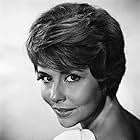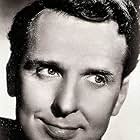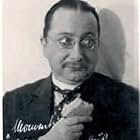Aggiungi una trama nella tua linguaPeter's fiancee Maria is chronically lying and hides her little affairs. To change this, Peter bets that he is going to tell everyone the truth for 24 hours. The consequences are catastrophi... Leggi tuttoPeter's fiancee Maria is chronically lying and hides her little affairs. To change this, Peter bets that he is going to tell everyone the truth for 24 hours. The consequences are catastrophic.Peter's fiancee Maria is chronically lying and hides her little affairs. To change this, Peter bets that he is going to tell everyone the truth for 24 hours. The consequences are catastrophic.
Foto
Trama
Lo sapevi?
- QuizAccording to some sources, this was the last film being shot in Berlin Babelsberg, when the Soviet tanks Rolled in the UFA studios in April 1945. Outside Berlin, work was still going on with "Das Leben Geht Weiter", and in Prag the filming continued with "Fledermaus" and "Shiva und die Galgenblume" until the very last days of the war. "Sag die Wahrheit" was later completed with some replacements in the cast.
- ConnessioniReferenced in Das Leben geht weiter (2002)
Recensione in evidenza
This film needs to be seen in context. Usually this is said about the films of the Nazi period - but this time we need to be honest enough to realize, that this film was made in a country, which had just lost the war and which was living under occupation (occupations, to be more precise). Hardly plausible, that the majority of the Germans considered the events of 1945 'a liberation'. It was an utter defeat and the film industry, which had been functioning until the very end of the Third Reich (the filming in Prag continued even after Berlin had fallen), had come to a total halt.
On October 15, 1946, Die Mörder sind unter uns, (Murderers Among Us) premiered in the Soviet sector. This is a film that deals with the guilt of the German people. On December 20, the Western cinema made it's debut with Sag die Wahrheit. This cinematic reply couldn't have been more different - this film is as far from reality of 1946 as can be. We see beautiful people wining and dining in unbearable elegance, solving their love problems, displaying the latest fashions. It's a direct descendant to the Nazi cinema, which created a carefree alternative reality that was designed to offer the viewers 90 minutes of oblivion.
Of course, the roots of this film lay in the Nazi cinema: the director had begun filming that particular script in early 1945. With a different cast, the film was shot until the morning of April 26, 1945, as the Soviets stormed the Tempelhof studios and the power cables were cut. Reportedly the leading lady, Hertha Feiler (the half Jewish wife of the leading man, Heinz Rühmann), was repeatedly raped in front of her husband. These were the last feet of footage, shot in the Third Reich (not counting Prag productions). After the war, the project was taken up again, with Weiss again directing, but with major replacements in the cast (Rühmann was banned for a while and couldn't do any film work). Actually, only minor roles were recreated - Ingrid Lutz and Else Reval appear to be recast. Could it be that some scenes have been filmed already in the spring of 1945? It's an interesting point, but then there are many films called 'Überläufer' or 'defectors' which were begun in the Nazi era and finished after the war, thus creating a strange cinematic bridge between two very different worlds.
As German classic comedies go, this is not a bad film. It's basically a witty farce and I am sure that the audience loved it - nothing and no-one speaks of defeat, of poverty, of fear or miserly. There are no ruins, no shortage of anything. For the viewer, it must have been a trip into the past - if only a very recent past. The official reviews, however, trashed the film completely. A new era had begun; the German cinema was supposed to lead the way with a sharp social commentary, not make its entrance with a banal comedy of manners. "These people are country clubbing and flirting to jazz music, and none of them seem to know, what honest work is," one critic wrote.
The cast is very likable and it's a pity, that it's not a musical comedy: almost everyone in the cast, notably the ladies (Ingeborg von Kusserow, Sonja Ziemann, Ingrid Lutz, Mady Rahl) as well as Gustav Fröhlich had several hit records to their names throughout their career.
Tell The Truth becomes a double entendre: it was as impossible to say certain things in 1946, as it had been between 1933-45. I admire the courage of the filmmakers to produce something that is so obviously turning its back to the reality that it becomes a loud social commentary in itself.
On October 15, 1946, Die Mörder sind unter uns, (Murderers Among Us) premiered in the Soviet sector. This is a film that deals with the guilt of the German people. On December 20, the Western cinema made it's debut with Sag die Wahrheit. This cinematic reply couldn't have been more different - this film is as far from reality of 1946 as can be. We see beautiful people wining and dining in unbearable elegance, solving their love problems, displaying the latest fashions. It's a direct descendant to the Nazi cinema, which created a carefree alternative reality that was designed to offer the viewers 90 minutes of oblivion.
Of course, the roots of this film lay in the Nazi cinema: the director had begun filming that particular script in early 1945. With a different cast, the film was shot until the morning of April 26, 1945, as the Soviets stormed the Tempelhof studios and the power cables were cut. Reportedly the leading lady, Hertha Feiler (the half Jewish wife of the leading man, Heinz Rühmann), was repeatedly raped in front of her husband. These were the last feet of footage, shot in the Third Reich (not counting Prag productions). After the war, the project was taken up again, with Weiss again directing, but with major replacements in the cast (Rühmann was banned for a while and couldn't do any film work). Actually, only minor roles were recreated - Ingrid Lutz and Else Reval appear to be recast. Could it be that some scenes have been filmed already in the spring of 1945? It's an interesting point, but then there are many films called 'Überläufer' or 'defectors' which were begun in the Nazi era and finished after the war, thus creating a strange cinematic bridge between two very different worlds.
As German classic comedies go, this is not a bad film. It's basically a witty farce and I am sure that the audience loved it - nothing and no-one speaks of defeat, of poverty, of fear or miserly. There are no ruins, no shortage of anything. For the viewer, it must have been a trip into the past - if only a very recent past. The official reviews, however, trashed the film completely. A new era had begun; the German cinema was supposed to lead the way with a sharp social commentary, not make its entrance with a banal comedy of manners. "These people are country clubbing and flirting to jazz music, and none of them seem to know, what honest work is," one critic wrote.
The cast is very likable and it's a pity, that it's not a musical comedy: almost everyone in the cast, notably the ladies (Ingeborg von Kusserow, Sonja Ziemann, Ingrid Lutz, Mady Rahl) as well as Gustav Fröhlich had several hit records to their names throughout their career.
Tell The Truth becomes a double entendre: it was as impossible to say certain things in 1946, as it had been between 1933-45. I admire the courage of the filmmakers to produce something that is so obviously turning its back to the reality that it becomes a loud social commentary in itself.
I più visti
Accedi per valutare e creare un elenco di titoli salvati per ottenere consigli personalizzati
Dettagli
- Data di uscita
- Paese di origine
- Lingua
- Celebre anche come
- Sag die Wahrheit
- Luoghi delle riprese
- Aziende produttrici
- Vedi altri crediti dell’azienda su IMDbPro
- Tempo di esecuzione1 ora 36 minuti
- Colore
- Mix di suoni
- Proporzioni
- 1.37 : 1
Contribuisci a questa pagina
Suggerisci una modifica o aggiungi i contenuti mancanti

Divario superiore
By what name was Sag' die Wahrheit (1946) officially released in Canada in English?
Rispondi







